
SON OF THE WHITE MARE
1981 - dir. Marcell Jankovics
"Once upon a time, in an uncertain place faraway from here, at the doors of Hell, there stood a tall turkey oak."


---
Synopsis
(beware spoilers!)
---

Content Warnings
- Flashing lights
- Artistic nudity




Review
Enchanting, fluid, and beautiful, Son of the White Mare is a film that utilizes color and movement to its full strengths, combining art with the classic hero’s journey in a way that honors its Hungarian roots. It is dedicated to the nomads of the ancient steppe, recalling their storytelling traditions and how it has impacted the history and culture of Hungary as a whole. Every moment of the film’s art direction was a conscious and purposeful choice – in fact, despite its psychedelic artstyle, the director Marcell Jankovics stresses that he did not take any drugs during its production, because he wanted to create a sublime, dreamlike realm for his audience to become lost in and enamored by. It is a heartfelt love letter to Hungarian storytelling, a testament to expressionism, and a heavy-handed social commentary all at the same time.
Admittedly, it took me a while to get through Son of the White Mare. While it is a breathtaking film, it is constantly moving and at times extremely vibrant. I’ve always been prone to headaches, so the multiple segments of quickly flashing lights were contributing to the psychedelic sensory overload that was creeping up on me. If you have trouble watching movies with flashing lights or extreme colors, I would be cautious watching this film or skip it entirely. If you’re able to watch, though, then you’re in for a treat.
The film is filled with a detailed attention to Hungarian folk culture and storytelling – for example, the white mare Feherlofia begins her story by talking about 77 dragons living on a tree with 77 roots and 77 crows that live on its 77 branches. This is a common way to open a myth in Hungarian culture, even if the actual myth is unrelated, which I hadn’t known before. While that and a few other cultural differences confused me at first when I watched, it was just as fun to research and learn about Hungary’s beautiful culture afterward!
One could argue that because it is based on a folktale, it suffers narratively. This could be true, but I personally disagree. Folktales are bound to be simpler than the more complex narratives we know today because they have been passed down for centuries. These stories sought to teach lessons or help understand the world around us through spiritualism, and thus, calling it “simple” in a critical way demeans a story that has been thousands of years in the making and insults an entire culture that is not often depicted in modern tales. Plus, the narrative openly points fingers at how modernization and industrialism have destroyed folk tradition; with every dragon becoming more and more modern and the land being ravaged by them, one can draw a comparison to how industrialism is destroying nature. One of Son of the White Mare’s main themes is the passage of time: Fanyuvo saves natural beauty from manmade horror, lives a happy life, then dies, only to see as a spirit that the progressing world is destroying nature once more. It is both the classic hero’s journey and a cultural warning about the future, and its audience spans time. Jankovics’ work helps immortalize a culturally integral story in a beautiful, vibrant manner while also warning his audience about the consequences of time and human progression.

Themes
- the hero's journey
- the progression of time
- modernization and industrialism
- unity and division




